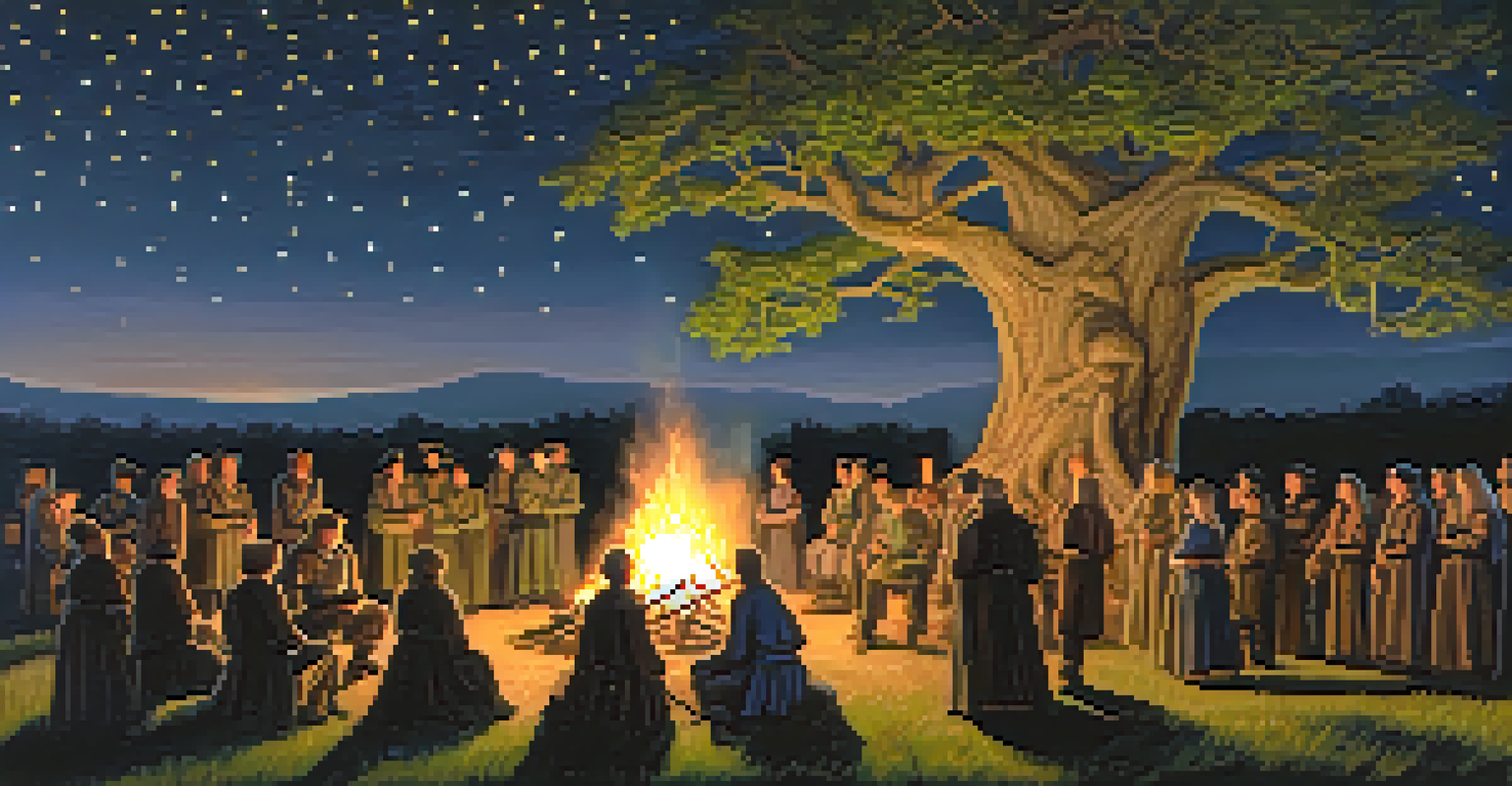The Role of Oak Trees in Celtic Mythology and Folklore

Introduction to Oak Trees in Celtic Beliefs
In Celtic mythology, oak trees hold a revered position, symbolizing strength and endurance. Often seen as sacred, these mighty trees were believed to connect the earthly realm with the divine. The Celts viewed oaks as protectors, embodying the spirit of the land and serving as a bridge between humans and gods.
The clearest way into the Universe is through a forest wilderness.
The oak's significance is deeply woven into Celtic rituals and traditions. It was common for ancient druids to gather under oak canopies to perform ceremonies, believing the tree's energy enhanced their spiritual practices. This connection underscores how the oak tree was not just a plant but a pivotal element in the cultural and spiritual life of the Celts.
Additionally, the oak tree's longevity and robust nature made it a symbol of resilience. Just as the oak withstands storms, the Celts viewed their own strength and unity as paramount in facing life's challenges.
The Oak Tree in Celtic Symbolism
The oak tree is rich in symbolism within Celtic culture, representing wisdom, strength, and protection. Its steadfast presence in nature made it a powerful emblem for the Celts, who believed that the oak held ancient knowledge. This belief is reflected in various myths where heroes seek guidance from oak spirits or druids under its branches.

Moreover, the oak's acorns were seen as symbols of potential and fertility, embodying the idea that great things can emerge from humble beginnings. This idea resonates with the Celtic belief in the cyclical nature of life, where every ending is merely the beginning of something new.
Oak Trees Symbolize Strength and Wisdom
In Celtic beliefs, oak trees are revered as symbols of strength, wisdom, and a vital connection between the earthly and divine realms.
Celtic art and literature often featured oak motifs, reinforcing its importance in their worldview. From carvings on stone to woven tapestries, the oak's image serves as a reminder of the deep connection between nature and the spiritual journey of the Celts.
Myths and Legends Surrounding Oak Trees
Numerous myths and legends highlight the oak tree's importance in Celtic folklore. One famous story tells of a hero who receives guidance from an oak spirit during a time of crisis, illustrating the tree's role as a source of wisdom. These narratives often emphasize how the oak tree serves as a guardian during perilous journeys.
In every walk with nature one receives far more than he seeks.
Furthermore, the presence of oak trees in Celtic mythology often signifies a connection to the Otherworld—the realm of the dead and the divine. The Celts believed that oaks acted as portals, allowing souls to travel between worlds, making them crucial in both life and death.
These tales have been passed down through generations, weaving the oak tree into the very fabric of Celtic identity. They serve not only as entertainment but as moral lessons and reflections on the human experience, rooted in the strength of the oak.
Druids and the Sacred Oak
Druids, the priestly class in ancient Celtic society, held the oak tree in the highest regard. They believed that oaks were imbued with spiritual energy, making them ideal locations for rituals and gatherings. The practice of 'druids' gathering under oaks reflects their deep reverence for these trees as sacred spaces.
The act of cutting down an oak tree was viewed with great caution, as it was believed to anger the spirits that inhabited it. This respect for oaks highlights the druids’ understanding of nature's balance and the importance of preserving sacred sites.
Druids Held Oaks as Sacred
Druids regarded oak trees as sacred spaces for rituals, reflecting their deep respect for nature and its spiritual significance.
Through their practices, druids fostered a connection between nature and spirituality, using the oak tree as a focal point. This relationship encouraged their communities to honor the natural world and recognize the wisdom that it offers.
The Oak Tree in Celtic Festivals
Celtic festivals often featured the oak tree as a central theme, celebrating its significance in the changing seasons. For instance, during the festival of Beltane, which marks the beginning of summer, oak boughs were used to symbolize fertility and growth. This practice demonstrated the tree's role in the cycle of life, death, and rebirth.
Similarly, during Samhain, the Celts honored the oak as a symbol of protection during the dark winter months. Bonfires were lit with oak wood to ward off evil spirits, reflecting the belief in the oak's powerful energy and protective qualities.
These festivals not only honored the oak but also reinforced community ties and cultural identity. They served as reminders of the interconnectedness between the Celts, their land, and the natural world around them.
Modern Interpretations of Oak in Celtic Culture
Today, the oak tree continues to hold significance in modern Celtic culture and spirituality. Many practitioners of neo-paganism and modern druidry still revere the oak, incorporating its symbolism into their rituals and celebrations. This enduring respect illustrates how ancient beliefs can adapt and thrive in contemporary settings.
Moreover, artists and writers draw inspiration from the symbolism of the oak, often portraying it as a symbol of resilience in their work. This reflects an ongoing appreciation for the oak's strength and its ability to endure the test of time.
Modern Reverence for Oak Trees
Today, the oak tree continues to inspire modern Celtic spirituality, symbolizing resilience and a connection to heritage and community.
Through these modern interpretations, the oak tree remains a powerful emblem of connection to heritage, nature, and community, showcasing the enduring legacy of Celtic beliefs.
Conclusion: The Lasting Legacy of the Oak Tree
The oak tree's role in Celtic mythology and folklore is a testament to its enduring legacy. From being a symbol of wisdom and strength to serving as a sacred gathering place for druids, the oak encapsulates the deep connection between the Celts and the natural world. This bond continues to resonate, reminding us of the importance of preserving nature’s wonders.
As we reflect on the stories and traditions surrounding the oak, we see how they offer insights into the values of resilience, community, and respect for the environment. These teachings remain relevant today, inspiring us to foster our own connections with nature.

Ultimately, the oak tree stands as a powerful reminder of our shared history and the timeless lessons that can be drawn from the natural world, encouraging us to honor and protect the environment around us.